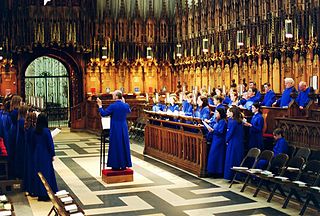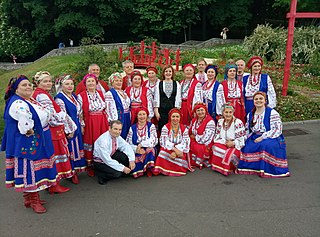Mtiebi is a Georgian singing ensemble performing traditional vocal polyphony.
Ensemble Mtiebi was formed in 1980 by Edisher Garakanidze (1957–1998), noted Georgian ethnomusicologist, scholar and performer. The ensemble was formed as a reaction to the increasing modernisation of the performance practices of Georgian traditional music, in order to reconstruct the traditional performance practice of Georgian villagers. The principles of the ensemble became: (1) to bring back the natural unity of singing and dancing (which was and still is disconnected in most of the contemporary Georgian folk ensembles), (2) to recover the tradition of the live improvisation on stage, including improvising poetry in traditional poetic competitions, (3) to present the traditional choreographic movements instead of the professionally developed staged dances.
Garakanidze did not organize the ensemble from seasoned singers of Georgian traditional songs. Instead he taught Georgian songs to his friends. Mtiebi members were often visiting villages, participating in village traditional celebrations. Despite their closeness to the village performance practices, Mtiebi did not try to emulate villagers and for a long time they were performing without traditional clothes.
Mtiebi toured extensively in European countries and in the United States, organizing performances and workshops. After the death of Edisher Garakanidze in 1998, his son Gigi became a leader of Mtiebi. Children's ensemble "Amer-Imeri" was established by Garakanidze (together with Nato Zumbadze), and today former Amer-Imeri singers comprise a new generation of Mtiebi. Although initially Mtiebi was an all-male ensemble, in Ameri-Imeri both boys and girls were taught Georgian songs and dance, and new generation of Mtiebi is a mixed ensemble.
Mtiebi had a profound influence on the development of the performance practices of Georgian traditional music. Female ensemble "Mzetamze" was established as a female counterpart of Mtiebi, based on similar principles. Ensemble "Anchiskhati" is another ensemble that was affected by the principles of Mtiebi. Performance principles of Mtiebi affected foreign ensembles of Georgian music as well, among them trio "Kavkasia" (USA-Canada), choirs "Darbazi" (Canada) "Marani" (France) as well as"Maspindzeli" and "Chela" choirs and "Buska" ensemble (UK). Mtiebi is widely regarded in Georgia as the first ensemble of the new generation that established the principles of village performance of Georgian traditional music and dance on a stage. Documentary film "Mtiebi" was produced in 1988 (director, Dimitri Gugunava).

In the most general of terms, music is the arrangement of sound to create some combination of form, harmony, melody, rhythm, or otherwise expressive content. Definitions of music vary depending on culture, though it is an aspect of all human societies and a cultural universal. While scholars agree that music is defined by a few specific elements, there is no consensus on their precise definitions. The creation of music is commonly divided into musical composition, musical improvisation, and musical performance, though the topic itself extends into academic disciplines, criticism, philosophy, psychology, and therapeutic contexts. Music may be performed using a vast range of instruments, including the human voice to sing, and thus is often credited for its extreme versatility and opportunity for creativity.

Polyphony is a type of musical texture consisting of two or more simultaneous lines of independent melody, as opposed to a musical texture with just one voice (monophony) or a texture with one dominant melodic voice accompanied by chords (homophony).

A choir is a musical ensemble of singers. Choral music, in turn, is the music written specifically for such an ensemble to perform. Choirs may perform music from the classical music repertoire, which spans from the medieval era to the present, or popular music repertoire. Most choirs are led by a conductor, who leads the performances with arm, hand, and facial gestures.

Overtone singing, also known as overtone chanting, harmonic singing, polyphonic overtone singing, or diphonic singing, is a set of singing techniques in which the vocalist manipulates the resonances of the vocal tract to arouse the perception of additional separate notes beyond the fundamental frequency that is being produced.
Ukrainian music covers diverse and multiple component elements of the music that is found in the Western and Eastern musical civilization. It also has a very strong indigenous Slavic and Christian uniqueness whose elements were used among the areas that surround modern Ukraine.

The music of Bulgaria refers to all forms of music associated with the country of Bulgaria, including classical, folk, popular music, and other forms.
Georgia has rich and still vibrant traditional music, primarily known for arguably the earliest polyphonic tradition of the Christian world. Situated on the border of Europe and Asia, Georgia is also the home of a variety of urban singing styles with a mixture of native polyphony, Middle Eastern monophony and late European harmonic languages. Georgian performers are well represented in the world's leading opera troupes and concert stages.
The music of Saint Lucia is home to many vibrant oral and folk traditions and is based on elements derived from the music of Africa, especially rhythmically, and Western Europe, dances like the quadrille, polka and waltz. The banjo and cuatro are iconic Lucian folk instruments, especially a four-stringed banjo called the bwa poye. Celebratory songs called jwé show lyricism, and rhythmic complexity. The most important of the Afro-Lucian Creole folk dances is the kwadril. Music is an integral part of Lucian folk holidays and celebrations, as well as the good-natured rivalry between the La Rose and La Marguerite societies. There is little Western classical music on Saint Lucia, and the country's popular music industry is only nascent. There are few recording opportunities, though live music and radio remain a vital part of Lucian culture. Popular music from abroad, especially Trinidadian styles like calypso and soca, is widespread.
Russian folk music specifically deals with the folk music traditions of the ethnic Russian people.

Music of Northeast China is tied closely to the region's history. Musical traditions of the Bang Zi Theatre and folk instruments such as the Dizi, Xiao and Baijiao Gu originate in the region. Folk songs from the north east are noted for their contributions toward nationalistic music the popular communist-era song “The East is Red” based upon a traditional Northern Shaanxi melody. The popularity of western musical traditions in the Harbin province are internationally recognised with the northern city being named a ‘music city’ in 2010 by the United Nations. Contemporary folk as well as modern pop music continue to contribute to the diverse musical traditions of the region. Prominent performers from the Northeast include the mid-20th-century film composer Lei Zhenbang and pop stars Xiao Ke and Na Ying.

The Rustavi Ensemble, or the Georgian State Academic Ensemble, is a Georgian folk music ensemble that was created in 1968 by Anzor Erkomaishvili, a singer and folklorist from a distinguished Georgian musical lineage that goes back seven generations. Since its formation Rustavi has successfully toured more than 50 countries of the world.

A rehearsal is an activity in the performing arts that occurs as preparation for a performance in music, theatre, dance and related arts, such as opera, musical theatre and film production. It is undertaken as a form of practising, to ensure that all details of the subsequent performance are adequately prepared and coordinated. The term rehearsal typically refers to ensemble activities undertaken by a group of people. For example, when a musician is preparing a piano concerto in their music studio, this is called practising, but when they practice it with an orchestra, this is called a rehearsal. The music rehearsal takes place in a music rehearsal space.

A show choir is a musical ensemble that combines choral singing with choreographed dance, often with an overarching theme. It is most relevant in the Midwestern United States and was popularized by the American television show Glee.

Ukrainian folk music includes a number of varieties of traditional, folkloric, folk-inspired popular music, and folk-inspired European classical music traditions.
Capilla Flamenca is a vocal and instrumental early music consort based in Leuven, Belgium. The group specialises in 14th to 16th century music from Flanders and takes its name from the historical Flemish chapel, the choir of the court chapel of Emperor Charles V. When the emperor left Flanders in 1517, he took his best musicians with him to Spain to accompany him as "living polyphony".
Lithuanian folk music belongs to Baltic music branch which is connected with neolithic corded ware culture. In Lithuanian territory meets two musical cultures: stringed (kanklių) and wind instrument cultures. These instrumental cultures probably formed vocal traditions. Lithuanian folk music is archaic, mostly used for ritual purposes, containing elements of paganism faith.

The East Is Red, also known as The East Is Red: A Song and Dance Epic, is a 1965 Chinese film directed by Wang Ping, based on an opera production. It is an abridged history of the Chinese Communist Revolution and the Chinese Communist Party (CCP) under the leadership of Mao Zedong, from the beginnings of the May Fourth Movement, to the Civil War against the Nationalist Party, and to the victory of the Communists and the founding of the People's Republic of China (PRC). The film is commercially available today on both CD and video, as well as online with English subtitles.

Susanne Rosenberg ) is a Swedish folk singer, professor, and researcher.

Bistritsa Babi are an elderly/multi-generational women's choir carrying on the traditional dances and polyphonic singing of the Shopluk region of Bulgaria. Founded in 1939, the group won the European Folk Art Award in 1978, and it was declared a Masterpiece of the Intangible Heritage of Humanity in 2005. Performing three-part polyphony with features "retained from the pre-Christian times," the group has toured Europe and the US. They are known for their use of Shopluk polyphony, costuming, dancing in a ring (horo), and performing the lazarouvane. In 2005 they were included in UNESCO List of Intangible Cultural Heritage elements in Eastern Europe.
Filipino Americans have a long history of music in the United States. The Philippines have musical context and varied influences due to indigenous traditions and early colonial influences of Spanish and American occupation. During occupation by the United States, many Filipinos were recruited for manual labor along the West Coast. These early laborers commonly would perform Spanish-influenced rondallas as well as choral groups. With many Filipinos living in the United States beginning around the 1900s, Filipinos have contributed towards early Americana staples such as blues and jazz, and continue to influence more modern contemporary genres such as hip hop and rock. American music has also been influential in the Philippines for artists and vice versa. Though contributing to the evolution of American music, large number of Filipino Americans have a strong identity with culture of the Philippines by participating or organizing traditional dances and musical performances, largely in the form of PCNs on university campuses. Traditional dances and musical performances commonly practiced in the US are rondallas, choral groups, and gong chime ensembles. College campuses often organize performances on campuses, but can also have characteristics unique to America, as many Filipino Americans want to share their experiences of living in America and perform a more neo-traditional variation of traditional performances.